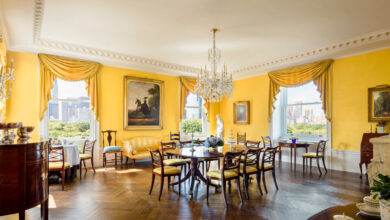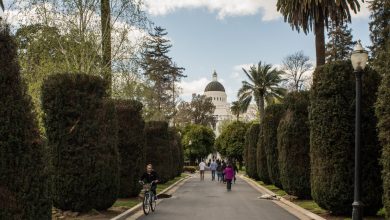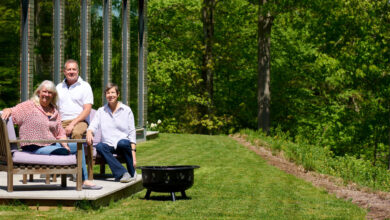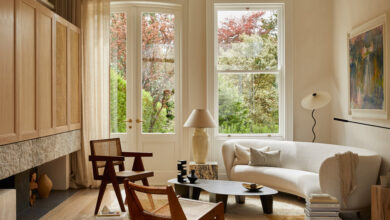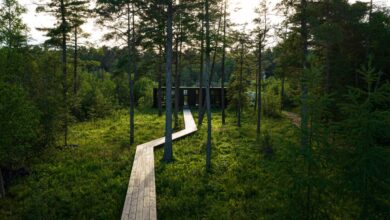In and Around Guadalajara, Homes Like Sanctuaries
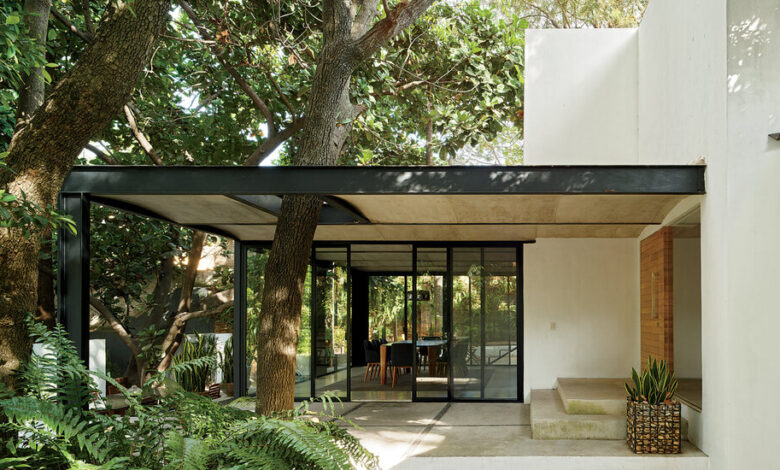
[ad_1]
The students who graduated from ITESO starting in the late 1990s — “a brilliant generation,” Ortiz calls them — have turned the Tapatío School outward once more, referencing a century of influences without becoming beholden to them. Notable among these architects is Alejandro Guerrero, who founded the firm Atelier Ars in 2006. For his wife, Andrea Soto, 33, who joined as a partner in 2011, Barragán is mostly notable for his use of boundaries to generate space. She and Guerrero took a similar approach with their 4,198-square-foot House With Seven Patios, a 2011 renovation of an unremarkable adobe ranchlike home from the 1980s, also in the Colonia Seattle. Maintaining what they could of the original 3,200-square-foot building, the architects added a glass-and-steel pavilion, which extends into a lush subtropical garden. Alongside the structure, a staircase folded from a long sheet of steel rises steeply between a pair of white plaster walls barely three feet apart. The claustrophobic proportions force the eye upward to a point where the steps end in a window without glass, a void framing a patch of sky. The whole house is an act of bricolage, from the surrealist staircase to the adobe embankment dripping with ferns against the neighboring plot. “Modern architecture sheds elements to make something abstract,” Guerrero says. But by incorporating such elements, “you’re connecting yourself to a history.”
Another pair of graduates from ITESO and Guerrero’s rough contemporaries, Salvador Macías Corona, 43, and Magui Peredo Arenas, 41, use different techniques to connect themselves to their city’s history, often through work that, at first glance, has only a tenuous connection to its forebears. Instead of covering exterior surfaces in plaster or stucco (finishes that, when mixed with cement and sand, are known in Guadalajara as enjarre, a term derived from the Spanish words for “grip” and “jug”), Macías and Peredo will often, like their colleagues in Mexico City, leave the brick and concrete of their outer walls exposed. The architects look not only to the Yucatán Peninsula and northern Portugal — places they feel resonate with the Tapatío sensibility — but to Japanese craftsmanship and the monumentalism of São Paulo, where “architecture is practically infrastructure,” Peredo says.
All of these traditions inform their recently completed Casa GZJZ, its exterior built almost entirely from exposed brick. But the home, for a family of four, is also unmistakably Tapatío: Each of those bricks was individually dipped in putty-colored cement, an artisanal finish on an industrial material. The wooden planks of a staircase are concealed between solid brackets of pale pink stucco that drop down into the 6,458-square-foot ground floor, like a monolithic sculpture at the center of a gallery. From outside, the slanted rooflines of its two rectangular volumes resemble, as Macías says, “a granary or a sophisticated ranch” — a quotidian vernacular imbued, like Zohn’s market, with a spirit of enchantment.
THE NEWEST GENERATION of Tapatío architects — most in their 30s, many of them former students of Ortiz and Aldrete, Guerrero and Gutierrez, Macías and Peredo — have come of age in a city that’s more cosmopolitan than that of their predecessors. Guadalajara’s cultural scene is thriving, with galleries, restaurants, artists’ studios and design shops tucked behind unprepossessing facades or opening onto tree-lined streets in the same colonias where Castellanos and Barragán built their earliest houses. Designers and makers who, even 15 years ago, might have settled in the capital or abroad have come home to collaborate with artisans and craftspeople in the surrounding region. The city’s recalcitrant conservatism has begun to relax even as its intimate, slower way of life remains intact.
Tradition still has its place here, of course, but so does the subtle irreverence that these contemporary architects have introduced. Consider, for instance, the Casa RC1, designed in 2018 for a family of five in the leafy suburb of Rancho Contento by the 35-year-old architect Saúl Figueroa. Community building guidelines require angled roofs with terra-cotta tiles, hollow gestures toward conventional forms that Figueroa both respects and subverts: By turning the slanting roof inward, he hides its surface from direct view and transforms the street-facing exterior of sand-colored stucco into a flat plane, like a cube sketched onto a piece of paper. Through a narrow patio, the main entrance opens into a cedar-paneled foyer fragrant with resinous wood, its far side a glass door that leads into the house’s interior patio. Surrounded by greenery, the room resembles a transparent pergola, a space delineated by a garden rather than a garden bound by walls.
[ad_2]
Source link


